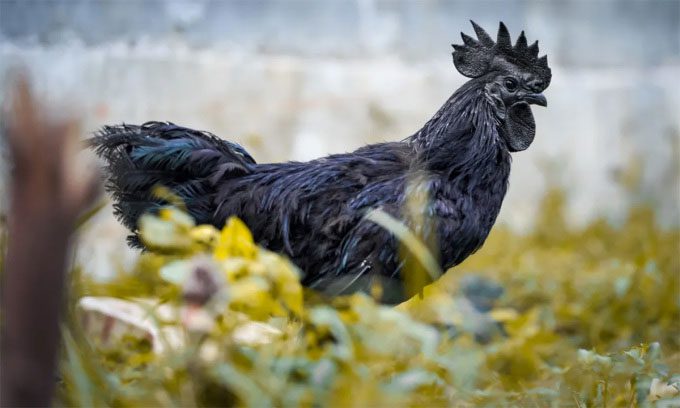The Ayam Cemani chicken is one of the darkest creatures on the planet due to a genetic mutation inherited from birds that lived hundreds or even thousands of years ago.
Black bones, tissues, and organs are extremely rare in the animal kingdom, and the Ayam Cemani chicken from Indonesia is one of the few examples. Their fascinating appearance comes with a special scientific explanation, which is a complex rearrangement in the gene structure, according to a report from IFL Science on August 3rd.

Ayam Cemani chicken with a solid black appearance. (Photo: Pap Wor/Shutterstock)
According to a study published in the journal PLOS One in 2017, the cause originates from genetics. Both the Ayam Cemani and Silkie breeds (Silkie chickens) have black tissue beneath their feathers, even though Silkie chickens are famous for their snow-white plumage. Both breeds exhibit a condition known as fibromelanosis, a type of hyperpigmentation that turns tissues black. The driving factor is likely a complex mutation involving the EDN3 gene, which encodes for endothelin-3 protein.
Endothelin-3 plays a crucial role in avian pigmentation by altering how melanocyte cells (the epithelial cells that produce pigment) are categorized, formed, and distributed throughout the body. The dark pigmentation in tissues is derived from melanin, which can be found throughout the animal kingdom.
The Ayam Cemani’s black coloration results from a mutation that may have occurred thousands of years ago, leading to enhanced expression of the EDN3 gene. This means it is expressed in nearly every cell in the body, resulting in the development of an embryo filled with pigment cells, from bones to beak.
According to Leif Andersson, a geneticist at Uppsala University in Sweden, the ancient genetic mutation leading to fibromelanosis is believed to have occurred only once in a single bird species hundreds or even thousands of years ago. “The mutation causing fibromelanosis is very special, so we are certain it only happened once,” he stated. Both the Ayam Cemani and Silkie breeds inherited this mutation.
The presence of black bones, organs, and beaks does not seem to affect the chickens’ lives. Furthermore, the ultra-pigmented meat is considered more valuable than regular chicken meat and may even offer health benefits.
“As a traditional herbal remedy and part of Chinese medicine, Silkie chickens are used to boost immunity and prevent the body from becoming frail and weak,” said researcher Ying-gang Tian. For a long time, black chicken meat has been believed to be beneficial for diabetes, anemia, menstrual cramps, and postpartum depression.
Tian and colleagues may have discovered the reasons for these benefits. In many parts of the world, a peptide called Carnosine (a chain of amino acids that helps synthesize various proteins) is used as a dietary supplement due to its benefits in enhancing muscle strength, promoting healthy aging, and controlling diabetes. Poultry is generally a rich source of Carnosine, but the dark meat of Silkie chickens contains up to twice the amount of Carnosine compared to regular White Plymouth Rock chickens.


















































